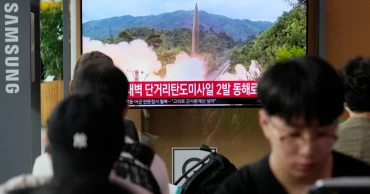short-range missiles
North Korea fires 2 short-range missiles into the sea as US docks nuclear submarine in South Korea
North Korea fired two short-range ballistic missiles into its eastern sea early Wednesday in what appeared to be a statement of defiance as the United States deployed a nuclear-armed submarine to South Korea for the first time in decades.
The launches came as the U.S.-led United Nations Command tries to secure the release of a U.S. soldier who fled to North Korea from the South Korean side of a border village Tuesday afternoon.
Private 2nd Class Travis King, in his early 20s, had just been released from a South Korean prison where he was held on assault charges. Instead of getting on a plane to be taken back to Fort Bliss, Texas, he left and joined a tour of the Korean border village of Panmunjom, where he ran across the border, U.S. officials say.
Kim vows to boost North Korea's nuclear capability after observing new ICBM launch
South Korea’s Joint Chiefs of Staff said that from 3:30 to 3:46 a.m. North Korea fired two short-range ballistic missiles from an area near capital Pyongyang that flew about 550 kilometers (341 miles) before landing in waters east of the Korean Peninsula.
Those flight details were similar to the assessment of the Japanese military, which said the missiles landed outside of Japan’s exclusive economic zone and that there were no immediate reports of damage from ships or aircraft in affected areas.
The flight distance of the North Korean missiles roughly matched the distance between Pyongyang and the South Korean port city of Busan, where the USS Kentucky arrived Tuesday afternoon in the first visit by a U.S. nuclear-armed submarine to South Korea since the 1980s.
Japanese Defense Minister Yasukazu Hamada told reporters that the North Korean missiles traveled on a low trajectory, with their maximum altitude reaching about 50 kilometers (31 miles), and possibly demonstrated “irregular maneuver” in flight.
North Korea launches long-range missile toward sea after making threat over alleged US spy flights
Japan has previously used similar language to describe the flight characteristics of a North Korean weapon modeled after Russia’s Iskander missile, which travels at low altitudes and is designed to be maneuverable in flight to improve its chances of evading missile defenses.
The South Korean Joint Chiefs of Staff condemned the North Korean launches as “major provocation” that threatens peace and stability in the region and said the South Korean and U.S. militaries were closely monitoring the North for further weapons activities.
North Korea opens key party meeting to tackle its struggling economy and talk defense strategies
Wednesday’s launches marked the North’s first ballistic activity since July 12, when it flight-tested a new solid-fuel intercontinental ballistic missile that demonstrated potential range to reach deep into the U.S. mainland. That launch was supervised by the country’s authoritarian leader Kim Jong Un, who vowed to further bolster his country’s nuclear fighting capabilities in the face of expanding U.S.-South Korean military activities, which he blamed for worsening the security environment on the Korean Peninsula.
Tensions have rose in the region in recent months as the pace of both North Korean weapons tests and U.S.-South Korean joint military drills have increased in a cycle of tit-for-tat.
Since the start of 2022, North Korea has test-fired around 100 missiles while attempting to demonstrate a dual ability to conduct nuclear attacks on both South Korea and the continental United States. The allies in response have stepped up their joint military training and agreed to increase the deployments of U.S. strategic assets like long-range bombers, aircraft carriers and submarines to the region.
Periodic visits by U.S. nuclear ballistic missile-capable submarines to South Korea were one of several agreements reached by U.S. President Joe Biden and South Korean President Yoon Suk Yeol in April in response to North Korea’s expanding nuclear threat. They also agreed to further expand combined military exercises, strengthen joint planning for nuclear contingencies and establish a bilateral Nuclear Consultative Group, which held its inaugural meeting in Seoul Tuesday.
The steps were meant to ease South Korean concerns about North Korea's growing nuclear weapons arsenal and suppress voices within the South calling for the country to pursue its own nuclear weapons program.
U.S. Forces Korea said in a statement that the Kentucky's arrival in Busan reflects the United States' “ironclad” commitment to “extended deterrence,” referring to an assurance to defend its ally with its full military capabilities, including nuclear ones.
The Ohio-class submarine can be equipped with about 20 Trident II ballistic missiles with a range of 12,000 kilometers (7,456 miles), according to South Korea's military.
“From this submarine, the U.S. can launch attacks (on North Korea) from anywhere in the world," said Moon Keun-sik, a submarine expert who teaches at Kyonggi University in South Korea. “But there will likely be backlashes from North Korea and China because it’s like the world’s most covert and threatening nuclear weapons forces being deployed on their doorsteps.”
While some South Korean conservatives have expressed disappointment that the Biden-Yoon meeting in April came short of agreeing to station U.S. nuclear weapons or strategic assets in the South, placing nuclear weapons offshore and on submarines is “actually a stronger deterrent in many ways,” said Duyeon Kim, a senior analyst at Washington’s Center for a New American Security.
“Deterrence is strengthened when the location of American strategic assets is unknown to the adversary as long as the adversary knows that these weapons exist,” said Kim.
Still, Seoul and Washington will need to find the “sweet spot” when it comes to the visibility of America’s extended deterrent.
“Too much visibility of strategic assets could actually undermine the deterrent effect while too little could raise questions in Seoul about commitment," Kim said.
2 years ago
North Korea fires short-range missiles after making threat
North Korea fired two short-range ballistic missiles off its eastern coast on Monday in its second weapons test in three days that drew quick condemnation from its rivals.
The weapons firings follow an intercontinental ballistic missile launch Saturday and North Korea’s threats to take an unprecedented strong response to U.S.-South Korean military drills that the North views as an invasion rehearsal. Some experts say North Korea could use a new testing spree to expand its arsenal and intends eventually to use its boosted capability as leverage in negotiations the United States.
South Korea's military said it detected the two missile launches from a western coastal town, just north of Pyongyang, the North Korean capital, on Monday morning. Japan said both missiles landed in the waters between the Korean Peninsula and Japan and that no damage involving aircraft and vessels in the area was reported.
According to Japanese and South Korean assessments, the North Korean missiles flew at a maximum altitude of 50-100 kilometers (30-60 miles) and a distance of 340-400 kilometers (210-250 miles).
South Korea’s military said North Korea’s repeated missile launches are “a grave provocation” that undermine international peace. Japan condemned the launches as a threat to the peace and safety of Japan and the international society.
Read: North Korea confirms ICBM test, warns of more powerful steps
The U.S. Indo-Pacific Command said the missile launches highlight “the destabilizing impact” of North Korea’s unlawful weapons programs. It said the U.S. commitments to the defense of South Korea and Japan “remain ironclad.”
North Korea’s state media said long-range artillery units on its western coast fired two rounds cross-country toward the eastern waters on Monday morning, possibly referring to the same activity its neighbors said were missile launches. The official Korean Central News Agency said the North Korean artillery rounds simulated strikes on targets up to 395 kilometers (245 miles) away.
The North said the launches involved its new 600 millimeter multiple rocket launcher system that could be armed with “tactical” nuclear weapons for battlefield use. Some experts viewed the weapons system as a short-range ballistic missile.
“The frequency of using the Pacific as our firing range depends upon the U.S. forces’ action character,” Kim Yo Jong, the powerful sister of North Korean leader Kim Jong Un, said in a statement carried by state media. “We are well aware of the movement of U.S. forces’ strategic strike means, (which are) recently getting brisk around the Korean Peninsula.”
Calling the United States “the worst maniacs,” she threatened to take unspecified “corresponding counteraction” in response to the future moves by the U.S. military.
She could be referring to the U.S. flyover of B-1B long-range, supersonic bombers on Sunday for separate training with South Korea and Japan. The B-1B deployment came as response to North Korea’s launch of the Hwasong-15 ICBM off its east coast on Saturday in the country’s first missile test since Jan. 1.
North Korea is extremely sensitive to the deployment of B-1B bombers, which can carry a huge payload of conventional weapons.
North Korea’s state media said Sunday the ICBM test was meant to further bolster its “fatal” nuclear attack capacity and verify the weapon’s reliability and the combat readiness of the country’s nuclear force. In her earlier statement Sunday, Kim Yo Jong threatened to take additional powerful steps over upcoming military drills between the United States and South Korea.
North Korea has steadfastly slammed regular South Korea-U.S. military drills as a practice for a northward invasion though the allies say their exercises are defensive in nature. Some observers say North Korea often uses its rivals’ drills as a pretext to hone and perfect its weapons systems.
The South Korean and U.S. militaries plan to hold a table-top exercise this week to hone a joint response to a potential use of nuclear weapons by North Korea. The allies are also to conduct another joint computer simulated exercise and field training in March.
Hours after Monday's launches, South Korea’s Foreign Ministry said Seoul placed unilateral sanctions on four individuals and five institutions it said were involved in illicit activities supporting the North’s nuclear arms development and evasion of sanctions. While South Korean President Yoon Suk Yeol’s government has so far placed sanctions on 31 individuals and 35 organizations for supporting the North’s nuclear ambitions, such steps are seen as mostly symbolic considering the lack of business activities between the rivals.
North Korea has claimed to have missiles capable of striking both the U.S. mainland and South Korea with nuclear weapons, but many foreign experts have said North Korea still has some key remaining technologies to master, such as shrinking the warheads small enough to be mounted on missiles and ensuring those warheads survive atmospheric reentry.
In her statement Monday, Kim Yo Jong reiterated that North Korea has reentry vehicle technology. She also hit back at South Korean experts who questioned whether North Korea’s ICBMs would be functional in real-war situations.
Kim Yo Jong insisted that the nine hours of launch preparation time after her brother Kim Jong Un ordered it included the efforts sealing the launch site and evacuating people, and was not long because of shortcomings of the missile system itself.
Last year, North Korea set an annual record with the launch of more than 70 missiles. North Korea has said many of those weapons tests were a warning over previous U.S.-South Korean military drills. It also passed a law that allows it to use nuclear weapons preemptively in a broad range of scenarios.
Kim Jong Un entered 2023 with a call for an “exponential increase” of the country’s nuclear warheads, mass production of battlefield tactical nuclear weapons targeting South Korea and the development of more advanced ICBMs targeting the U.S.
2 years ago



